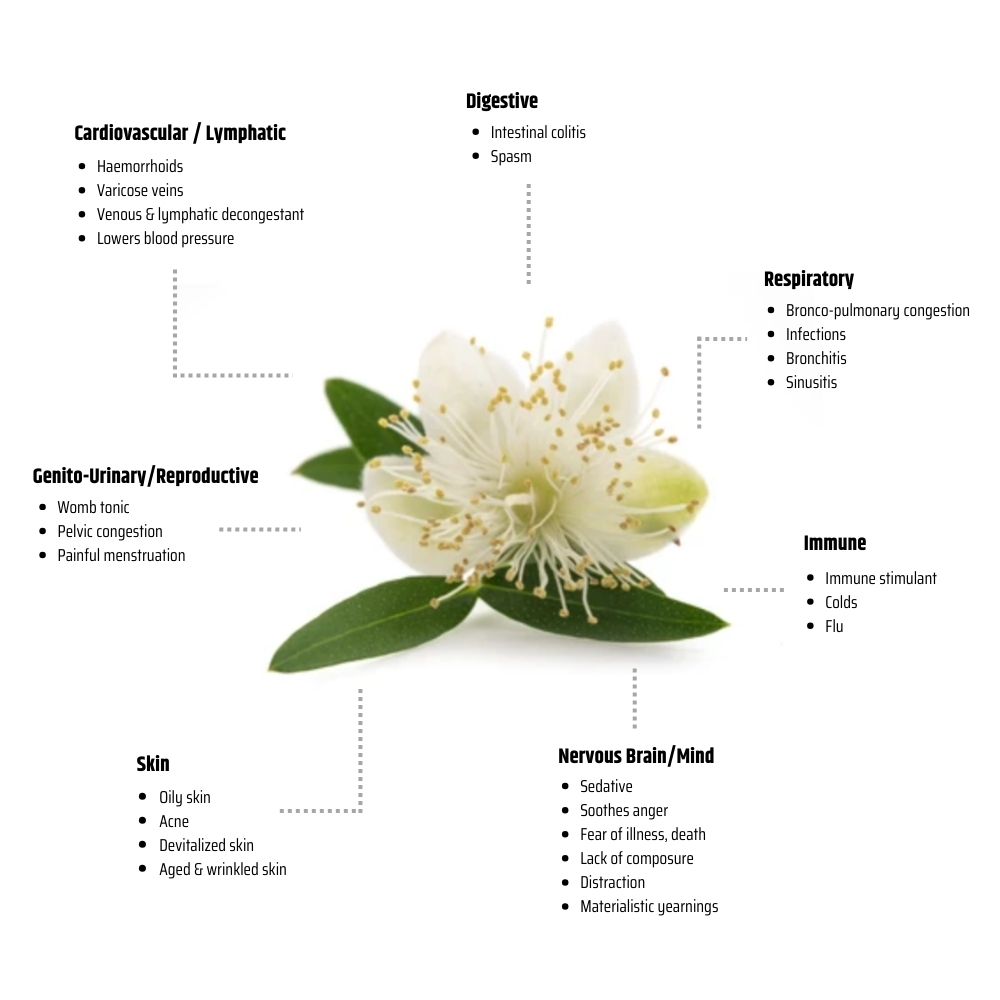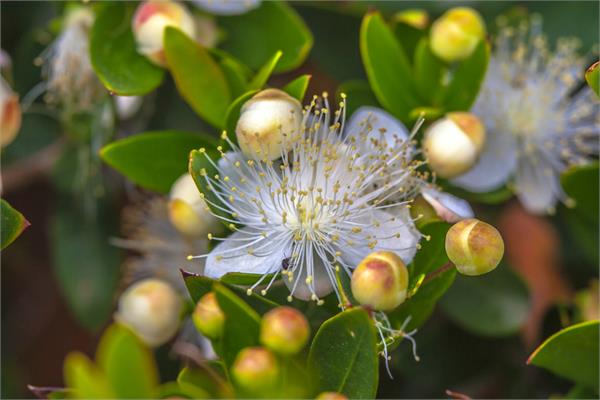
Australian Owned and Operated We have been proudly running for over 30 years

100% Pure & Natural Our products are sourced from the highest quality suppliers and growers from around the world

Not Tested on Animals None of our products are tested on animals

Vegan Friendly Our products are plant based and vegan friendly
Myrtle
Myrtus communis
Source: Plant
Origin: Morocco
Energetics: Yang
Extraction Method: Steam Distilled
Scent: Similar to Eucalyptus, Myrtle has a fresh, herbaceous aroma.
Blends Well With: Clary Sage, Lavender, Rosemary, Tea Tree, Hyssop, Ginger and Bergamot.
About
Myrtle essential oil was traditionally used to treat sore throats and coughs. It has vulnerary, astringent and antiseptic properties that may give you a plethora of health benefits.
Historical Snippets
Myrtle symbolised love throughout ancient Greece and Rome. It was often planted around temples, worn as crowns by Eleusinian Mystery priests and in a 16th century skin formula called “Angels Water”. Myrtle was also incorporated into Greek weddings and is still today. The plant's properties were described by Culpepper as “drying and binding”, so it was used to treat wet conditions such as diarrhoea and dysentery.
How To Use
Diffuse: Add a few drops to a diffuser to disperse around the room
Topically: Dilute essential oil with any carrier oil at a 2.5% ratio. This equates to 2.5ml essential oil/oils in total mixed with 100ml of chosen carrier oil. 1ml of essential oil is approximately 20-22 drops of oil. Decant into a roller or glass bottle with eye dropper to apply easily or a larger bottle if using for massage. Please note this dilution rate is for adults and children over the age of 6. More information on children and essential oils is on our blog page. Essential Oils should not be used directly on the skin without mixing first with a carrier oil
Inhalation: Add 1-2 drops essential oil to a tissue and inhale at a distance while ensuring that the oil does not come into direct contact with the skin. Alternatively, you can smell the oil directly from the bottle.
Shelf Life
Our freshly decanted Myrtle essential oil will last for 2-3 years minimum from when you open your amber glass bottle if stored correctly.
Primary Storage Considerations: Keep away from direct light (U.V. radiation). Keep in the amber glass bottle with lid tightly closed. Only open when you need to and decant into a smaller "working" amber glass bottle if possible (and label so you know what is in it). This is to reduce oxidation.
Secondary Storage Considerations: Keep in a refrigerator at around 4 degrees celsius.
Safety
General
Some essential oils may cause photosensitivity to the skin - Use diluted in Jojoba or other complete carrier oil.
Do not ingest essential oils.
Do not apply to eyes, sensitive areas or mucous membranes.
The information on this website is not intended to be used in the diagnosis, treatment or mitigation of any physical or mental illness. Ahimsa Oils offer no advice or recommendations only general information. No therapeutic claims are made within.
Pregnant women, nursing mothers and children should not use essential oils without first consulting an appropriately trained healthcare practitioner.
The statements on this website have not been evaluated by the TGA. David Bosley however worked for a long period in consultation with the TGA to ensure correct labelling with reference to the Ahimsa Oil product range.
Specific
Hazards: Drug interaction; potentially carcinogenic, based on estragole and methyleugenol content.
Maximum dermal use: 1.9%
It's recommended that a dermal maximum of 1.9% based on 1.4% eugenol and 0.8% methyleugenol content or 0.2% estragole and 1.0% methyleugenol content with dermal limits of 0.12% and 0.02% respectively.
References
Sheppard-Hanger, Sylla. The Aromatherapy Practitioner Reference Manual: Atlantic Institute of Aromatherapy, 1999. Print.
Tisserand, R., & Young, R. (2014). Essential Oil Safety: Second edition.



 Available for $100 orders and over
Available for $100 orders and over



